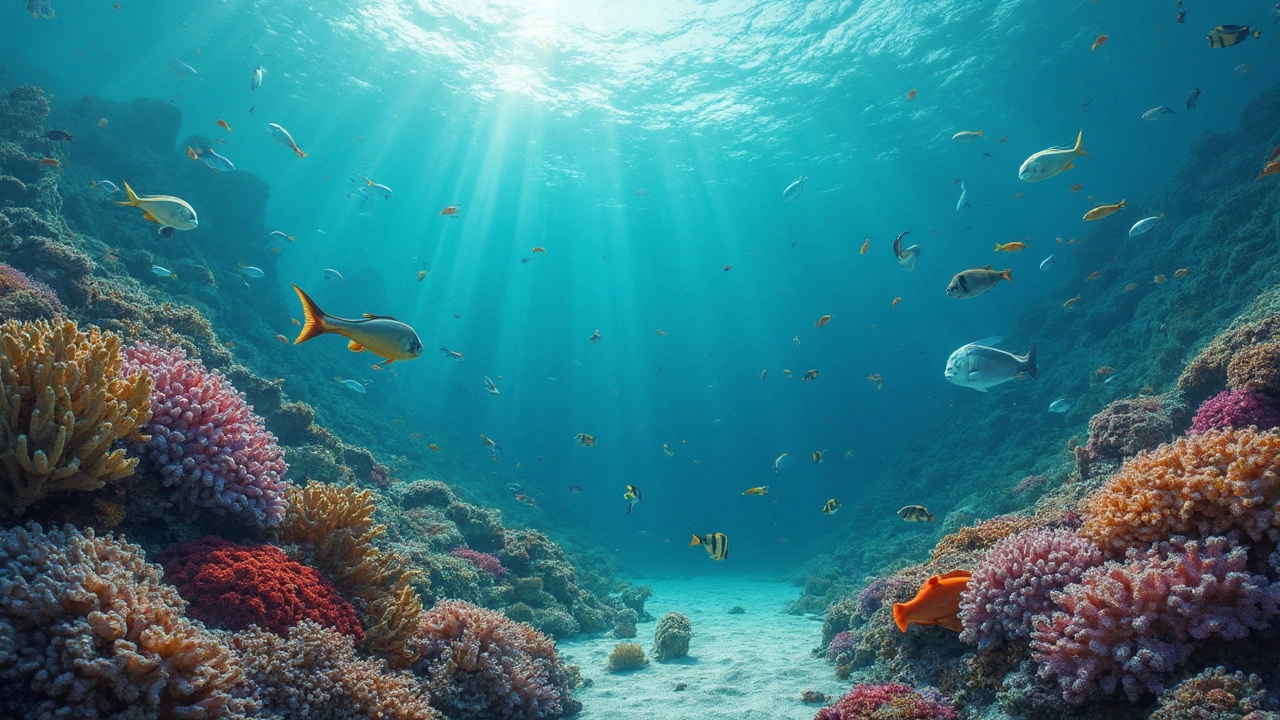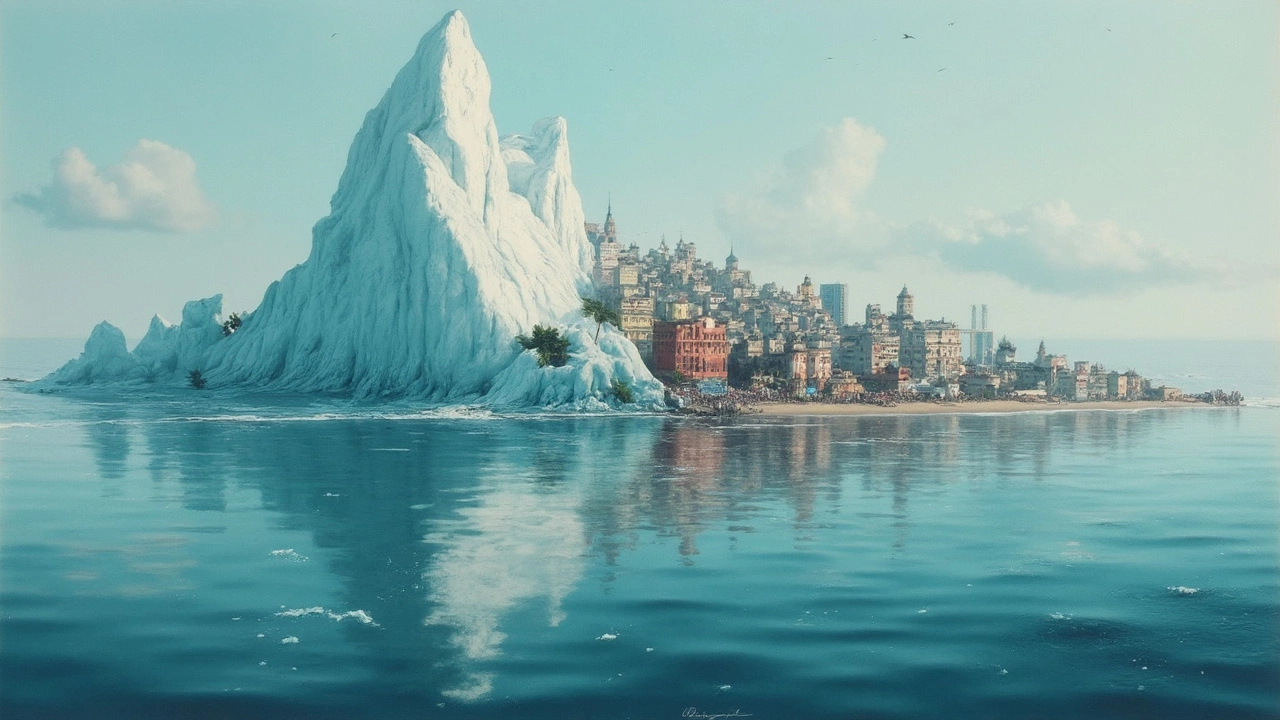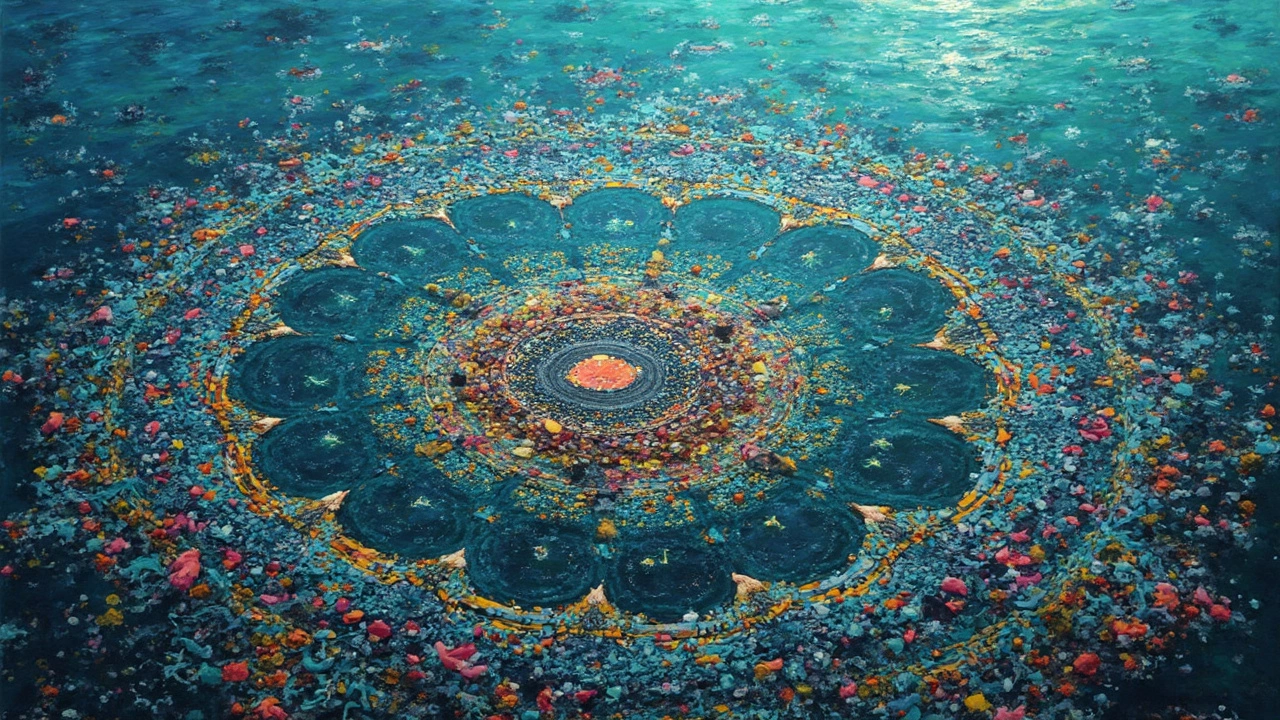Biggest Threats to Ocean Life from Climate Change
 Mar, 17 2025
Mar, 17 2025
Our oceans are facing a crisis that’s challenging their very survival. Climate change isn’t just about warmer summers and heavier rainstorms; it’s reshaping ocean life in drastic ways. Have you ever wondered how rising temperatures might affect what's below the surface? Well, let's break it down.
As the Earth's climate warms, so do our oceans. Those temperature shifts? They're stressing marine ecosystems big time. Corals, which are super critical to marine life, are bleaching and dying faster than ever, all because they can’t cope with the heat. Can you imagine the underwater chaos?
But that's just one slice of the pie. These changes aren’t just warming waters; they're also making them more acidic. Yes, you heard that right—our oceans are acting more like soda pop, and that’s bad news for creatures like shellfish. Imagine trying to build a home in an acidic environment. It's almost impossible, and marine life is struggling to adapt.
- Rising Ocean Temperatures
- Ocean Acidification
- Melting Ice Caps
- Pollution and Marine Life
- Conservation Efforts
Rising Ocean Temperatures
Climate change is heating up our oceans faster than a kettle on a stove. This isn’t just a headline—it's a massive problem for marine life. Our waters are absorbing more than 90% of the excess heat trapped by greenhouse gases. Imagine living in a house where the thermostat is constantly creeping up, with no way to cool down—that's what's happening underwater.
Rising ocean temperatures are particularly nasty for coral reefs. These underwater rainforests are bleaching, which means they're stressed to the point of expelling the algae living in their tissues, turning them ghostly white. Without these vibrant homes, many fish and marine creatures are left without shelter or food sources.
Impact on Marine Life
It's not just corals feeling the heat. Fish are either moving to cooler areas or finding it hard to reproduce effectively. Warmer waters can disrupt migration patterns and breeding cycles. Ever heard of species like the Atlantic cod or the Pacific salmon? They're finding their habitats way less cozy than before.
- Species displacement: Fish and marine creatures are forced to migrate to cooler regions.
- Reduced oxygen levels: Warmer water holds less oxygen, which can suffocate marine organisms.
- Habitat loss: Critical ecosystems like seagrass meadows and mangroves are under threat.
The Big Picture
As temperatures soar, sea levels are rising too, mainly due to melting ice caps. This combo leads to more frequent and severe weather events, damaging coastal ecosystems and human communities alike. Noteworthy is that sea surface temperature has already increased by about 0.13°C per decade over the past 100 years.
The ultimate takeaway? We need to tackle climate change at its roots. Efforts like reducing fossil fuel consumption and supporting marine conservation programs are steps in the right direction. Every action counts, and the ocean desperately needs our help.
Ocean Acidification
Ever heard of the term ocean acidification? It's a not-so-great phenomenon caused by all the carbon dioxide (CO2) we’re pumping into the atmosphere. The oceans absorb about a quarter of this CO2, and that makes the water more acidic. Sounds like a chemistry lesson, right? But it's happening in real life and affecting ocean life big time.
Now, what's the big deal if the ocean gets a bit more acidic? Let's break it down. For starters, it’s a nightmare for calcifying organisms like coral reefs and shellfish. These creatures rely on calcium carbonate to build their shells and skeletons, and acidification makes it harder for them to do that. Imagine trying to build a house when the bricks keep dissolving. Frustrating, right?
The Data Behind the Change
Check this out: over the past few decades, our global oceans have become about 30% more acidic. That's fast in nature's timeline. Think of it like your favorite gigantic aquarium with the water chemistry suddenly going haywire. Not fun for the fish inside!
Impact on Marine Life
So what happens to ocean life when things get too acidic? Here's a peek:
- Coral bleaching: Corals struggle to maintain their skeletons, leading to more frequent bleaching events.
- Shellfish troubles: Creatures like oysters, clams, and sea snails are finding it tough to grow their shells.
- Fish behavior: Even fish are impacted—with changes in acidity affecting their sense of smell and navigation skills. Imagine a fishy traffic jam!
These changes aren't happening in isolation. They disrupt entire food chains and ecosystems. What's bad for shellfish isn't just their problem. It affects everything that relies on them, including humans who love their seafood platters.
Understanding ocean life challenges like acidification helps us figure out how to protect these ecosystems. Simple actions like reducing CO2 emissions can have a big impact. Remember, it's all connected, and the health of our oceans directly influences us too.

Melting Ice Caps
When we talk about climate change and its threats to ocean life, melting ice caps are often at the center of the conversation. These icy giants are pretty much our planet's air-conditioning system. But what happens when they start to thaw?
As temperatures rise, ice caps and glaciers in places like Greenland and Antarctica are melting at an alarming rate. This isn't just a polar bear problem—though it seriously is for them—it's an issue for the entire globe, especially the oceans. The meltwater from these ice caps is flowing into the oceans, causing sea levels to rise. Higher sea levels mean that we're losing coastal habitats, which are home to countless marine species.
Impact on Marine Species
When the ice caps melt, it doesn’t just mean more water—it means colder, fresh water mixing into the oceans. This addition of cold water can disrupt marine currents, which impacts species that depend on specific water temperatures. Many fish species find their breeding grounds disrupted, forcing them into new areas where food may be scarce.
In fact, the changes in sea temperatures and currents can alter entire marine ecosystems. Phytoplankton, the tiny organisms crucial for the ocean food chain, also suffer. With them being affected, the ripple effect moves up to fish, sea birds, and even larger marine mammals. Everyone's impacted.
How Fast Is This Happening?
You might wonder about the speed of this change. NASA and other research organizations have shown data indicating that the melting rate of ice caps has doubled in the recent decades. Here's a quick look:
| Year | Ice Cap Melt Rate (km³ per year) |
|---|---|
| 2000 | 75 |
| 2010 | 150 |
| 2020 | 300 |
These numbers aren't just figures on paper; they represent massive changes that are reshaping our world and affecting ocean life deeply.
What Can We Do?
So, how do we tackle this? While individual actions like reducing carbon footprints help, large-scale changes are crucial. Governments and organizations need to invest in renewable energy and protect existing ice caps through stringent climate policies. It isn't just about saving ice; it's about preserving life as we know it.
Understanding the dynamics of melting ice caps helps us see the bigger picture of marine threats from climate change. Acting on this knowledge is essential for the oceans—and for us.
Pollution and Marine Life
Pollution is one of those big risks that often fly under the radar when we talk about threats to ocean life. It's not just about plastic bags floating in the sea but a whole bunch of nasties that are wreaking havoc underwater.
Plastics: The Unwanted Souvenir
Ever heard of the Great Pacific Garbage Patch? It's like a massive pile of floating trash in the ocean, mostly made up of plastics. This doesn't just look bad; it's downright dangerous. Marine animals, from tiny fish to gigantic whales, mistake this trash for food. It's a buffet of toxic non-food that'll mess with their digestive systems.
Oil Spills: The Sticky Situation
Oil spills, though infrequent, can be catastrophic. When oil coats the sea surface, it blocks sunlight, crucial for the survival of marine flora like plankton and seaweed. These plants are critical in the marine food web, providing food for countless sea creatures.
Chemicals: The Hidden Danger
Industries often discharge chemicals like heavy metals and pesticides into waterways, which eventually flow into the ocean. These chemicals accumulate in the tissues of marine organisms, causing health problems or even death. Ever wondered why mercury contamination is a big no-no in seafood? Well, it's because of this chemical pollution.
| Pollutant | Impact on Marine Life |
|---|---|
| Plastics | Ingestion, entanglement |
| Oil | Blocks sunlight, damages reefs |
| Chemicals | Toxic accumulation, health issues |
What Can We Do?
Reducing pollution starts with us. We can cut down single-use plastics, advocate for cleaner industry practices, and support organizations working to clean up our oceans. Simple steps like these can make a world of difference.

Conservation Efforts
It's not all doom and gloom for our ocean life when it comes to climate change. There are various conservation efforts taking place right now, aimed at preserving marine ecosystems and combating the threats posed by environmental shifts. Let's explore what's being done and how everyone can pitch in.
Marine Protected Areas (MPAs)
One of the most effective strategies to protect marine life is the establishment of Marine Protected Areas. These are regions where human activity is controlled to safeguard biodiversity. Currently, there are over 5,000 MPAs worldwide, covering about 7% of the world's oceans. While that might sound impressive, experts argue we need to protect at least 30% by 2030 to slow down ocean degradation.
Sustainable Fishing Practices
Overfishing is a huge issue, but countries are working towards implementing sustainable fishing practices. This involves enforcing catch limits, using selective gear to reduce bycatch, and protecting crucial habitats. The goal here is simple: allow fish populations and their environments to recover and thrive.
Reducing Carbon Footprint
Reducing carbon emissions doesn’t just help our skies; it impacts the oceans too. Numerous global initiatives are underway to cut down on greenhouse gases. Switching to renewable energy sources, enhancing energy efficiency, and even advocating for cleaner transportation options are all part of the tools being used to combat climate change effects in our oceans.
Community Involvement and Education
Local communities play a crucial role in conservation. Educating people about the importance of marine life and how their actions affect it is a powerful tool. Beach clean-ups, reducing plastic waste, and supporting sustainable seafood choices can create significant ripple effects. Knowledge is power, and spreading the word can lead to big change.
In summary, the efforts to protect our oceans are a mix of global policies and individual actions. It's about everyone doing their bit, whether that's governments, industries, or people like you and me, stepping up to ensure a brighter future for our planet's waters.